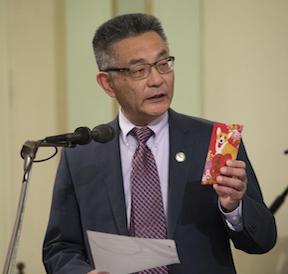KansenChu

Kansen Chu photo
California Assembly Member Kansen Chu has introduced a bill to establish a path for physical therapists who want to work on animals. He's shown here speaking in February about the Year of the Dog.
Two visions of the future of animal physical rehabilitation in California are set to clash on April 10, when a new bill comes before the state Assembly Business and Professions Committee. As drafted, AB 3013 would create a legal basis for licensed physical therapists to provide rehabilitation therapy to animals without the direct supervision of a veterinarian. The proposal runs counter to recent regulatory recommendations from the California Veterinary Medical Board (CVMB).
The bill expands the scope of the physical therapy practice act to include the treatment of animals. In addition, it creates an advanced certificate in animal physical rehabilitation in the state’s veterinary medicine practice act and allows physical therapists to operate independent animal rehabilitation practices by referral from a veterinarian.
Proponents, led by the bill-sponsoring Animal Physical Therapy Coalition, hail the legislation for expanding veterinary health-care options for consumers. Opponents, led by the California Veterinary Medical Association (CVMA), said in an action alert that they believe the bill will put animals at risk and place undue liability on referring veterinarians.
Currently, California's veterinary practice act generally is interpreted as allowing licensed human medical professionals such as physical therapists to treat animals only if they are under the direct supervision of a veterinarian.
The bill was introduced by Assembly Member Kansen Chu, a Democrat representing the South and East Bay regions. According to Chu's chief of staff John Nam, there are two central reasons for the bill. One is to provide greater choice for consumers seeking animal physical therapy services. The second reason is to support small independent businesses such as physical therapy practices and protect them from “burdensome” requirements. “The crux of the issue is whether or not it’s fair for the person providing the physical therapy to the animal to have to be on the premises of the veterinarian's office,” Nam said. “We’re not sideswiping the process. The veterinarian is still much in the process of physical therapy."
The CVMA disagrees on that score, saying the legislation circumvents minimum standards that include the provision of a licensed veterinarian overseeing any premises where the practice of veterinary medicine occurs. “Physical therapists are educated in human medicine,” the CVMA said. “A certification in animal physical therapy does not give them the necessary education or experience to make independent decisions regarding the care and treatment of an animal patient.”
The field of animal rehabilitation therapy has grown steadily during the past two decades. Along the way, veterinary medicine has been adapting, expanding animal-rehabilitation-related education and establishing a board certification in veterinary sports medicine and rehabilitation. Specialization now exists for veterinary technicians, too.
Simultaneously, independent programs have been established to train and certify physical therapists who want to work with animals. In response, state veterinary professional boards and associations have been working to set parameters for these non-veterinary professionals.
But most states have not addressed the intersection of physical therapy and veterinary medicine. The words “physical therapy” do not appear in the majority of state practice acts that govern veterinary medicine, according to a summary by the American Veterinary Medical Association. Regulations in just 10 states specify that physical therapy falls under the scope of veterinary medicine and/or that physical therapists can treat animals if supervised by a veterinarian.
Seven states have adopted some version of an indirect-supervision model for animal physical therapy. The states are Colorado, Nebraska, Nevada, New Hampshire, Oregon, Utah and Virginia. These states allow licensed physical therapists with defined training, experience and certification to perform physical/rehabilitation therapy on animals with the clearance or referral of a veterinarian. That therapy can be administered away from a veterinary clinic and without the direct supervision of a veterinarian.
The California bill embraces the clearance or referral approach. This same model was recommended last year to the CVMB by a task force comprised of veterinarians, physical therapists and other stakeholders. But the CVMB rejected those recommendations. AB 3013 would essentially go around that decision to make the task force recommendations law.
Speaking for Chu, Nam said this is the first step of a multi-step process. “Only a small number of stakeholders actually knew that this was happening,” he said about the veterinary board hearings last year. “Now with the legislative process, it’s much more of a public dialogue. We can just see how it goes from here.”
Meanwhile, the CVMB has been working the regulatory process. In October, it reiterated its rejection of the task force recommendations by making proposed revisions to the veterinary practice act, specifying that animal physical rehabilitation is included in the practice of veterinary medicine and stating the circumstances under which registered veterinary technicians and veterinary assistants could provide animal rehabilitation. Physical therapists are not mentioned.
Getting that language adopted is the next step, said CVMB Interim Executive Officer Ethan Mathes. That process could take 12 to 18 months. AB 3013 “is a significant scope-of-practice change,” Mathes said, “and there are several concerns the board has about the current bill language that contradict the board’s regulatory proposal.”
If the bill passes, it would supersede the board regulations in this area, making them moot.